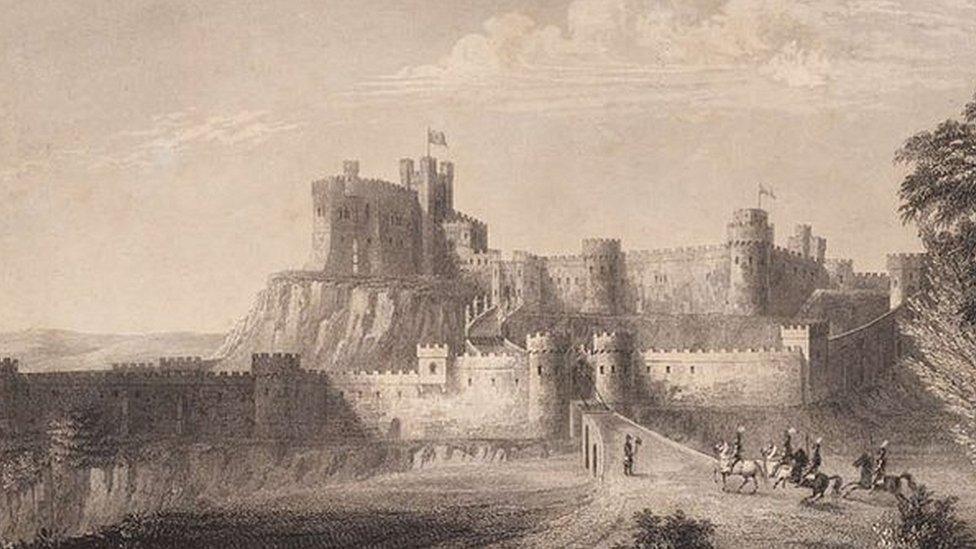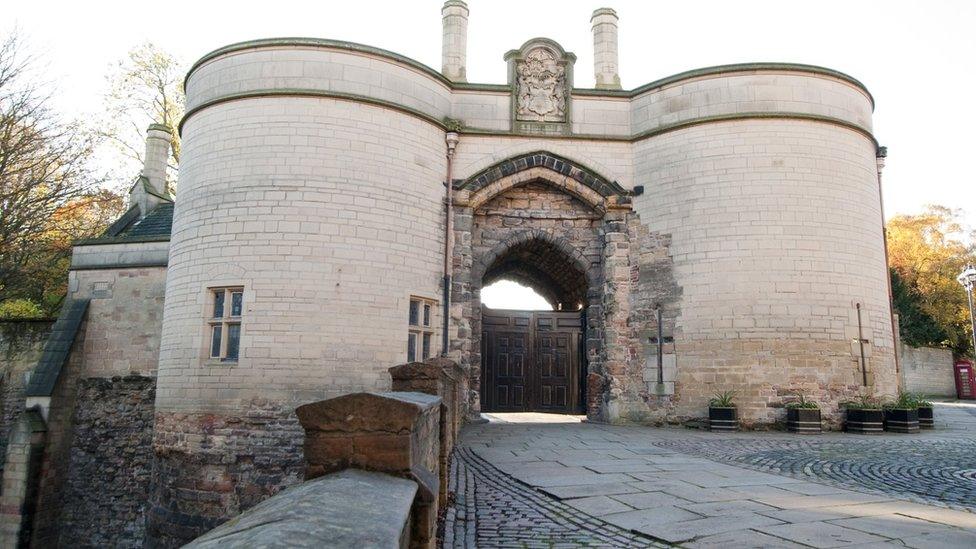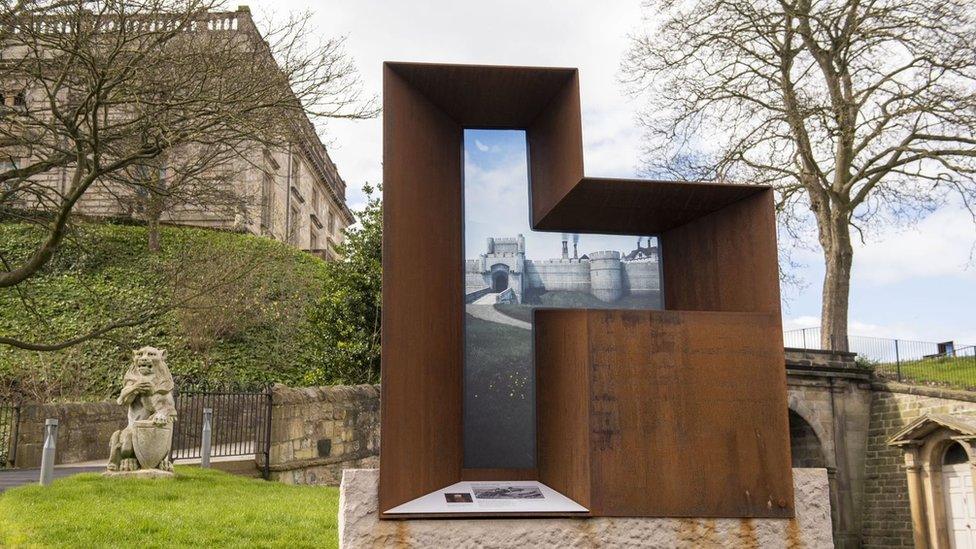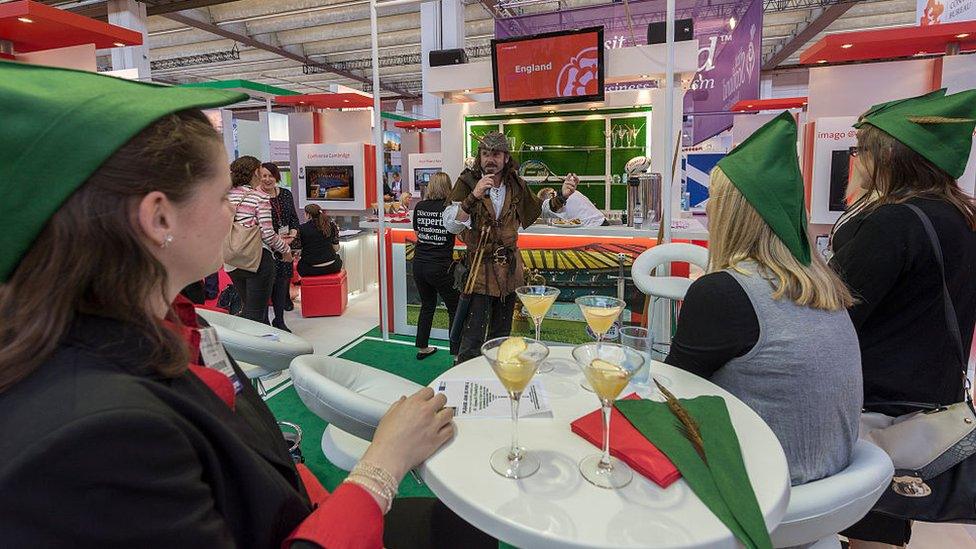Nottingham Castle: City hopes to shed 'workaday' image with £30m refurb
- Published

A romanticised view of the castle which features prominently in the legends of Robin Hood
"It's not a traditional castle, it's not a Windsor or a Warwick, so we have to manage expectations."
Nottingham Castle is reopening after a three-year, £30m refurbishment project, with the city's tourism bosses hoping it will attract 300,000 visitors a year.
Not bad, seeing as the medieval castle was demolished more than 350 years ago and its most famous association - Robin Hood - is likely to have been a myth.
What is left is largely a Victorian rebuild of the 17th Century mansion subsequently built on the site.
So can it compete in the crowded tourism marketplace and overcome Nottingham's "workaday city" image?

The main building on the site today, the ducal palace, sits on top of a large cliff where the castle keep once stood
Debbie Beardall from the Nottingham Castle Trust, which will run the site, said: "The castle is massively important to the city and the wider area.
"It's good for the wellbeing of people who live here and visitors can really boost the economy.
"Despite it not [being] a castle, there is a lot of amazing stuff instead."
So what do you get for £30m?

The new galleries will display varied elements of Nottingham's history, like lace making.
Outwardly not much has changed, the only new building being a visitor centre and cafe.
But several galleries have been added and refurbished to tell the story of the city's industry and its rebellious history.
A space for temporary exhibitions will kick off with a display by locally born fashion designer Paul Smith.

Wrecked ramparts and busted battlements

The gatehouse - heavily restored in the early 20th Century - is the only part of the castle still resembling a fortress
Nottingham Castle was once one of the great royal fortresses in Britain and is not short of fascinating legends.
But, sticking with historical fact, it was where the young Edward III seized power from his mother and her lover. From these walls Richard III rode out to meet Henry Tudor at Bosworth.
And on a piece of ground a stone's throw away, Charles I raised his standard and started the English Civil War.

The new layout uses castle-like windows to give an idea of what was once there
Its history after that is still interesting - but less beneficial from a tourism point of view.
After the civil war the keep and walls, already semi-derelict, were demolished.
The main building now on the site - known as the Ducal Mansion - was built in the 1660s but was gutted by fire during political riots in 1831.
After standing empty for years, it was converted into a small museum.
An additional blow came when the warren of medieval streets between the castle and the city centre were largely demolished by a dual carriageway in the 1960s.

But what of Nottingham's trump card, star of dozens of big and small screen adaptations, its truly globally-recognised brand - Robin Hood?
Ms Beardall said: "We'd be mad not to talk about Robin Hood and many people would be disappointed if we didn't."

Parts of the castle will celebrate the mythical hero
She said there was a gallery devoted to the Hood legends and a themed children's play area.
"But not everyone wants that, so we show lots of others parts of Nottingham's culture and history," she added.
She added that as it was not a "traditional castle", it was important to manage expectations.

Robin Hood and his marketing men

The Robin Hood brand - here seen at a German trade fair - has a global reach
Nottingham's attempts to market the man in Lincoln green are a saga in their own right. Ambitious plans for a new Sherwood Forest destination were massively scaled back in 2007 after they missed out on £50m of lottery funding in a public vote, external.
In 2009 Nottingham's only dedicated attraction at the time, The Tales of Robin Hood, closed due to falling visitor numbers, external. The same year the city council set up a commission, ironically headed by the city's sheriff, to brainstorm ideas.

The most ambitious plan was for a theme park-style attraction near Sherwood forest
Plans for a £25m medieval village at the castle were swept away by the recession. Another lottery bid - this time to the Heritage Fund to renovate the castle - was turned down in 2013.
Back in Sherwood Forest, a Robin Hood theme park - complete with jousting and a pretend castle - was championed by the county council. The plans collapsed in 2014 when private funding could not be found.
Only in 2016 was the castle's revised bid for lottery funding confirmed, with the project also being backed by the city council, arts council and local business fund.

Getting people back to the castle - particularly post-Covid - involves serious money.
Visit England said tourism spending in the East Midlands amounted to £5.2bn, external - the second lowest in England, with the South East making almost three times as much.
In 2019 the most visited paid-for heritage attraction in the UK outside London was Chester Zoo with more than two million visitors, external.
In the East Midlands, it was Chatsworth House, with 606,000.

Chatsworth House is the number one tourist draw in the East Midlands, with 600,000 visitors annually
Can the renovated castle compete?
Professor Scott McCabe, from the University of Nottingham's Business School, underlined how important it could be.
He said: "Heritage is a massive part of the UK's tourist offering, especially to high-spending visitors from abroad.
"And in Robin Hood the city has a global brand, which for whatever reason it has struggled to market.
"With the redevelopment the castle is offering Robin Hood, but also a wider story of history."

Can child-friendly offerings, like the Hood's Hideout play area, put Nottingham on the tourist map?
But the challenge of attracting those 300,000 visitors is laid bare by John Johnson, from Johnsons Coach Holidays.
His company operates around 50 coaches on more than 500 tours in the UK and abroad.
"Nottingham is not high on our list of priority cities," he said.
"It has an image of a workaday city - it's not a York or Lincoln.
"I hadn't heard of the castle's relaunch. It sounds interesting, we would definitely take a look, but they need to get the message out there."

Managers said the contrasting landscape around Segedunum Roman fort was part of its appeal
One destination which might sympathise with Nottingham's endeavours is Segedunum, once a major fort on Hadrian's Wall, now sat among the post-industrial landscape of Wallsend, in the North East.
Museum manager, Geoff Woodward, said: "It's certainly a challenge.
"While it is the most excavated fort on Hadrian's Wall, there's not that much remaining and we don't have the greatest collection of objects.
"But the good thing about having a dearth of material is you make the most of what you do have."

Staff at Segedunum museum say they work hard to meet changing audience expectations
Backed by an initial £9m of lottery funding, old shipyard buildings were converted into a museum and a 30m (98ft) observation tower was built. It opened in 2000.
"We have 45,000 visits a year and we really try to meet changing audience expectations," said Mr Woodward.
"There is a reconstructed bathhouse and a section of Hadrian's Wall and we are one end of the wall's coast-to-coast trail.
"We don't have the picturesque crags of somewhere like Housesteads but we have a dynamic landscape, one that was shipyards and coalmines and housing."

It took some imagination - and investment - to turn this archaeological find into a tourist magnet
An even more ambitious attraction started as a lot of mud and damp wood.
Excavations in the Coppergate area of York between 1976 and 1981 uncovered 40,000 objects and preserved timbers from Viking buildings.
How did this become the premier tourist destination that is the Jorvik Viking Centre?
The answer was an automated ride through reconstructed Viking houses, complete with sounds, voices and - famously - smells.
Shrugging off criticism that it was dumbing down, the centre - pre-Covid - attracted about 400,000 visitors a year.

The Jorvik Centre bills itself as an attraction, rather than a traditional museum
Its CEO David Jennings said: "We tried to revolutionise the way people engage with the past.
"We want to be accessible to all. We see ourselves as an attraction as opposed to a museum but one with very high standards of authenticity.
"People who come here are given a lot of information, they learn almost without realising they are learning."
Jorvik Centre opened in 1984 at cost £2.4m and has has two multi-million refurbishments in the past 20 years - all raised privately.
Mr Jennings said: "It obviously helps being in York, which is already a prime heritage destination.
"There is a lot of competition for people's attention, so you need to be distinctive and very clear in what you are offering.
"But it shows the heritage sector is still vibrant."

Follow BBC East Midlands on Facebook, external, on Twitter, external, or on Instagram, external. Send your story ideas to eastmidsnews@bbc.co.uk, external.
Related topics
- Published17 June 2021

- Published25 May 2021

- Published11 May 2021

- Published19 April 2021

- Published2 April 2021

- Published11 April 2017

- Published23 April 2016

- Published8 March 2014
